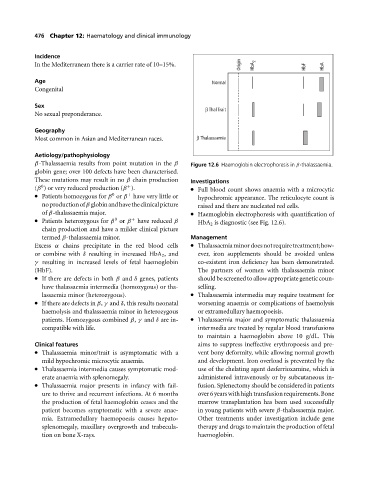Page 480 - Medicine and Surgery
P. 480
P1: KOA
BLUK007-12 BLUK007-Kendall May 12, 2005 20:37 Char Count= 0
476 Chapter 12: Haematology and clinical immunology
Incidence
Origin HbA 2 HbF HbA
In the Mediterranean there is a carrier rate of 10–15%.
Age Normal
Congenital
Sex
β Thal Trait
No sexual preponderance.
Geography
Most common in Asian and Mediterranean races. β Thalassaemia
Aetiology/pathophysiology
β-Thalassaemia results from point mutation in the β Figure 12.6 Haemoglobin electrophoresis in β-thalassaemia.
globin gene; over 100 defects have been characterised.
These mutations may result in no β chain production Investigations
0
(β )orveryreduced production (β ). Full blood count shows anaemia with a microcytic
+
Patients homozygous for β or β have very little or hypochromic appearance. The reticulocyte count is
0 +
noproductionofβ globinandhavetheclinicalpicture raised and there are nucleated red cells.
of β-thalassaemia major. Haemoglobin electrophoresis with quantification of
Patients heterozygous for β or β have reduced β HbA 2 is diagnostic (see Fig. 12.6).
0 +
chain production and have a milder clinical picture
termed β-thalassaemia minor. Management
Excess α chains precipitate in the red blood cells Thalassaemiaminordoesnotrequiretreatment;how-
or combine with δ resulting in increased HbA 2 , and ever, iron supplements should be avoided unless
γ resulting in increased levels of fetal haemoglobin co-existent iron deficiency has been demonstrated.
(HbF). The partners of women with thalassaemia minor
If there are defects in both β and δ genes, patients shouldbescreenedtoallowappropriategeneticcoun-
have thalassaemia intermedia (homozygous) or tha- selling.
lassaemia minor (heterozygous). Thalassaemia intermedia may require treatment for
If there are defects in β, γ and δ, this results neonatal worsening anaemia or complications of haemolysis
haemolysis and thalassaemia minor in heterozygous or extramedullary haemopoeisis.
patients. Homozygous combined β, γ and δ are in- Thalassaemia major and symptomatic thalassaemia
compatible with life. intermedia are treated by regular blood transfusions
to maintain a haemoglobin above 10 g/dL. This
Clinical features aims to suppress ineffective erythropoesis and pre-
Thalassaemia minor/trait is asymptomatic with a vent bony deformity, while allowing normal growth
mild hypochromic microcytic anaemia. and development. Iron overload is prevented by the
Thalassaemia intermedia causes symptomatic mod- use of the chelating agent desferrioxamine, which is
erate anaemia with splenomegaly. administered intravenously or by subcutaneous in-
Thalassaemia major presents in infancy with fail- fusion. Splenectomy should be considered in patients
ure to thrive and recurrent infections. At 6 months over6yearswithhightransfusionrequirements.Bone
the production of fetal haemoglobin ceases and the marrow transplantation has been used successfully
patient becomes symptomatic with a severe anae- in young patients with severe β-thalassaemia major.
mia. Extramedullary haemopoesis causes hepato- Other treatments under investigation include gene
splenomegaly, maxillary overgrowth and trabecula- therapy and drugs to maintain the production of fetal
tion on bone X-rays. haemoglobin.

